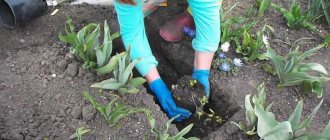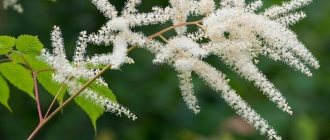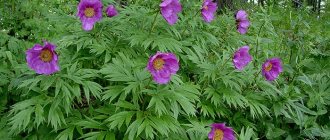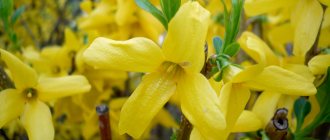Clematis is one of the most beautiful climbing plants. It owes its undeniable charm to its beautiful shape and interesting appearance of delicate flowers. These plants have gorgeous hues and a delightful profusion of flowers. With proper care, timely pruning, properly prepared position and supports, we can get a magnificent, profusely flowering vine that will decorate the yard for ten years. We will tell you how to grow clematis - planting and care in open ground, how to prune it correctly.
Clematis as a plant for open ground
Clematis belongs to the ranunculaceae family. There are about three hundred varieties of this plant, which has won the tender love of all gardeners. They strive to plant it in the most prominent places in order to create comfort and a bright mood on the site. Often it is clematis that decorates the gate and is the first to “greet” guests. Thanks to the different types of this plant, which can be not only a liana, but also a shrub, you can even create flowering hedges.
Clematis flowers can be small or large, and their shapes and shades are simply amazing in their incredible diversity. Different varieties bloom at different times over a period of 3-4 months. Thanks to this, you can create a bright kaleidoscope of blooming clematis in your garden, which will delight the eye throughout the warm season from spring to early autumn.
The main decorative value of clematis is its abundant flowering.
Most often, clematis is cultivated in the ground, but it will also feel quite comfortable as a houseplant.
It is usually planted in pots, boxes or tubs (at least 60 cm high), placed in a well-lit place. Several holes must be made in the bottom of the container, then drainage and fertile soil are filled in, and after planting, a support for the plant must be installed. To provide the roots with coolness and shading, low-growing “neighbors” are planted in a pot of clematis.
Under comfortable conditions, clematis can bloom for up to five years without replanting.
Hello, dear readers!
Let's continue the conversation about our proud beauty - clematis. Many gardeners love it, but not everyone decides to plant clematis on their site.
They are afraid that both planting and caring for clematis will require significant time and attention. And completely in vain!
Clematis is quite independent and not capricious. Like every plant, it has its own preferences, knowing which we can find a common language with our king of vines. And it will delight us with its lush and long-lasting flowering.
What determines the attractiveness of clematis?
Planting and care, done competently and competently, guarantee good health and longevity of the beautiful flower. A hastily planted vine will not please the owner with rich flowering.
In which regions can you plant in open ground?
Thanks to large-scale breeding work to develop various winter-hardy varieties, clematis has quite easily taken root in the northwestern regions of the country, Siberia and the Far East. But in order to admire the bright colors of summer even in harsh climates, it is important to choose the right varieties whose vines successfully withstand frost.
Clematis flowers are painted in almost all colors of the spectrum, also differing in an infinite number of shades
Table: clematis varieties by planting region
| Name | Color | Where are they planted? |
| Nellie Moser | White and pink with bright lines in the center | Central Russia |
| Gypsy Queen | Violet-magenta | |
| Niobe | Purple red | |
| Hope | Powdery burgundy | Central Russia, Siberia |
| Luther Burban | Violet | Central Russia, Siberia, Ural, North-West, Far East |
| Ballerina | Snow-white | Central Russia, Siberia, Ural |
| Ville de Lyon | Carmine with a fuchsia tint and light stamens | Ural, Far East, Siberia |
| Alexandrite | Bright crimson | |
| Nellie Moser | Light pink | Ural |
| Gypsy Queen | Violet with a dark purple tint | North-West, Far East, Siberia |
| Jacqueman | Burgundy, pink, purple | Northwest |
| Melody | Pearl pink | |
| Elegy | Blue-purple | Southern regions |
| Climber | Pastel lilac | |
| Teal | Soft lilac | |
| Openwork | Pink-violet | |
| Ruitel | Dark purple |
Landing nuances
Most often, clematis is planted in open ground in mid-May. But if the seedling was purchased in the summer, planting should be done in September so that the plant has the opportunity to take root. This should not be done earlier because of the high probability of increased growth (which is not at all necessary during winter) and freezing.
Planting clematis consists of several stages:
- Choosing a location . The plant loves sunny, but slightly shaded areas, which allows it to maintain the brightness and richness of the flowers. In addition, it needs reliable protection from wind and drafts.
- Soil selection . Clematis likes light, nutritious, loose soil that quickly absorbs moisture. It is strictly forbidden to plant clematis in heavy, highly acidic soil, which will inevitably lead to the impossibility of its full development and death. It is important to take into account the level of soil moisture: the plant does not tolerate the abundance of groundwater. To create the most comfortable conditions and protect the roots from rotting, it is better to place the plant on a small artificial hill made by yourself. The presence of clay soil in the area chosen for planting clematis requires removal of moisture from the plant using a ditch dug and filled with sand.
- Pit preparation. Its depth should be no more than 70 cm. First, a layer of crushed stone is placed on the bottom, then a specially prepared soil substrate (a bucket of earth, half a bucket of humus, 100 g of slaked lime).
During autumn planting, the entire volume of soil is filled in immediately.
- Planting a seedling . The roots of the plant are evenly distributed across the width of the hole, after which the substrate is poured on top. If planting occurs in the spring, this is done in such a way that the depression is not completely filled, while the remaining soil is added in small portions until the fall.
When planting clematis near the walls of buildings, it is necessary to retreat 40 cm from them so that the roots cannot be damaged by rain flows from the roofs. If a composition of several bushes is planted, the gaps between them should be at least 25 cm.
Video: planting clematis in open ground
Sowing seeds
Cultivated varieties of clematis are grafted onto the roots of winter-hardy species. Beautiful plants are propagated by woody and green cuttings, as well as layering and seeds.
Clematis seeds are obtained in the summer through artificial pollination. Of course, in this case, the main characteristics of the plant will suffer variability. You will get a completely new plant with a unique genotype, for example, the flowers will not necessarily have the parent's color, size and aroma. The leaves of the plant will also not become an exact copy of the parent ones; the new generation may take on a different shape.
Species of clematis germinate in different ways. For example, larger seeds of Clematis flammula, straight Clematis rēcta and lilac Clematis viticella, as well as a representative from the clematis section - prince - Clematis sibirica - germinate from one and a half to 8 months.
The medium size fraction includes seeds of Clematis integrifolia, Manchurian (Clematis manschurica), and grape-leaved (Clematis vitalba). They are characterized by the appearance of friendly shoots that appear within one and a half to six months.
The smallest seeds are distinguished by Clematis heracleifolia, Fargeza and Tangut. Compared to other seed fractions, they germinate the fastest - from 2 weeks to 3 months.
Before sowing, clematis seeds are soaked for a long time; this event takes from several to 5 days. It is advisable to wash the seeds using the bubbling method using an aquarium compressor for a day or two. It is believed that such a procedure will significantly improve seed germination and have a beneficial effect on the further development of the seedling.
Feed and water. How to care for clematis in summer Read more
Before sowing, the seeds are subjected to another treatment. They are kept for at least half an hour in an artificially created substance, which is an analogue of a natural plant biostimulant. It is believed that it is able to develop additional immunity in plants, which will allow them not to suffer from any negative phenomena. According to the producers, they will not care about over-dried soil that is not watered on time; low temperatures in the form of spring and summer frosts and even heavy downpours.
Another most popular preparation for soaking seeds contains a complex of humic acids. These substances are nothing more than compounds obtained as a result of the decomposition of plants, turning into humus. Humic acids are found in the organic matter of peat and some soils. The seeds are soaked in a solution of this drug for 8-10 hours. Manufacturers claim that soaking seeds in such a preparation will make it possible in the future to increase plant resistance to various diseases.
Experts believe that it is best to stratify clematis seeds at a temperature of about +5 °C, since germination at room temperature negatively affects germination rates and germination energy.
Seeds are subjected to stratification from two weeks before germination.
King of the garden. Any cottage will be decorated with clematis Read more
Features of care
The main care for clematis consists of timely, sufficient watering and fertilizing.
Watering
Clematis should be watered at least once a week. During the summer heat, its frequency increases up to 2–3 times. At the same time, 1-2 buckets of water are enough for a baby bush, while for an adult - from 2 to 4. Covering the soil with a layer of mulch (peat, moss, humus) will help reduce the frequency of watering several times and slow down the growth of weeds around clematis. If this is not done, you should regularly (the next day after watering) loosen the soil, simultaneously breaking through the weeds.
Fertilizer
It is also important to know that certain types of fertilizers need to be used at different times:
- nitrogen-containing - during intensive growth;
- potassium - during the formation of buds;
- phosphorus - after the end of flowering.
In summer (after pruning), the plant is fed with a solution of complete mineral fertilizer (20 g per 10 liters of water) and a copper solution. Every year in the spring, the bushes must be watered with lime milk (dolomite flour and chalk). During the flowering period, all feeding is stopped so as not to drown out the activity of the plant itself.
To protect the roots from rot during frequent summer rains, you should cover the bottom of the trunk with wood ash.
Supports
There are several types of supports for vines (arches, pyramids, fan structures, cylinders), each of which is perfect for clematis. Supports allow you to create beautiful compositions and support plant stems. Another requirement is the strength of the construction material, which could withstand the weight of rapidly growing and moisture-laden clematis after rains.
The main thing is that the place where the stem is attached to the support is no thicker than 10–12 mm
Trimming
The correct formation and beauty of the bush depends on this procedure. Pruning is carried out several times a year:
- when planting (to form the crown and root system);
- in spring (to increase the flowering period);
- in summer (regulatory pruning);
- before wintering (taking into account the characteristics that each species requires).
The ability to tiller is a characteristic feature of clematis
Preparing for winter
Before wintering, it is necessary to remove leaves from clematis and trim off damaged and dried out branches. After this, remove it from the support, lay it on the ground and cover it using dry grass and leaves, straw, and sawdust.
Another option is to build a wire frame around a plant laid on the ground, covered with roofing felt, film, roofing felt or a plywood box. At the same time, it is important to ensure that the shelter is not sealed and has air access.
Clematis usually overwinters well. It is much more destructive for it to delay opening in the spring, as a result of which it can dry out.
In spring, it is necessary to free the plant from shelter as soon as the threat of night frosts has passed.
Garter
In the spring, when the buds begin to swell on the surviving clematis shoots, they must be carefully lifted and tied to supports. It is better to do this at the very beginning of the growing season, because then the shoots will become very brittle. When the average daily temperature rises to about 10 degrees, the shoots will begin to grow very quickly, up to 10 cm per day. At the same time, shoots with unexpanded leaves cling poorly to supports, but they cling well to each other. If you do not monitor the growth of the shoots, they will weave into dense balls, where the leaves will not have enough light. To avoid tangles, clematis must be regularly straightened and tied up.
Supports for clematis
Most varieties either do not cling to supports at all, or cling only to natural ones, but they cannot cling if the diameter of the support exceeds 1.5 cm. Moreover, the weight of an adult clematis is considerable, and a light wooden or bamboo structure can collapse. Welded metal supports and wooden supports with a stretched mesh of metal or nylon ropes performed best.
Pruning clematis
Depending on the type of flowering and winter hardiness, clematis are divided into three pruning groups:
- 1- very winter-hardy and bloom on last year’s shoots. They do not need any pruning or shelter, they simply overwinter on supports.
- 2 - the least winter-hardy and bloom the first time on the shoots of the previous year, and the second time - on the shoots of the current year. They are cut at a height of 60...100 cm above a pair of strong buds and the remaining shoot is carefully covered.
- 3 - blooming on the shoots of the current year and usually quite winter-hardy. Clematis of the third pruning group are cut at approximately a height of 30 cm and also covered. However, many varieties are quite winter-hardy, and a bucket of peat is enough for them, which is used to cover the tillering unit.
Errors in care and their elimination
The beauty and health of any plant depends not only on proper care. It is equally important to select plants intended for the climatic conditions of a particular region.
Recent Entries
Lilac perennials that are beautiful, compact and do not crowd out other plants Why when buying seedlings you should not take the sellers’ word for it and how to determine the age of the plant using 3 signs Tomato seedlings have turned purple or whitish: why the color has changed and how to save the plants
In case of any changes in weather conditions, it is necessary to carry out preventive examinations and measures in order to prevent the occurrence of various plant diseases.
A common mistake made by inexperienced gardeners is improper watering of clematis, which causes its root system to die and the stems to become victims of diseases and pests.
Excessive dampness can cause clematis to be damaged by pathogenic fungi.
The most common diseases that clematis suffers from are:
- Withering. It is caused by a fungus and is accompanied by a loss of elasticity of the shoots, after which they dry out, wither, and without treatment the plant may die. The reasons may be stagnation of moisture and poor drainage of the soil. Treatment consists of removing all damaged shoots and watering the plant with a solution of “Fundazol” (1 g per liter of water), spraying with a 3% solution of copper sulfate (in spring), regularly loosening the soil and removing weeds.
- Gray rot. Plaque in the form of brown spots on leaves and shoots covered with grayish “fluff”. Usually appears during rainy times. To combat it, the affected areas are removed, and the plant is treated with a solution of Azocene or Fundazol.
- Powdery mildew . It is caused by a fungus and looks like a whitish coating on the plant, similar to spilled flour. At the same time, its growth and flowering slows down. For treatment, spraying with a copper-soap solution (25 g per 250 g, respectively, diluted in 10 liters of water) or a solution of soda ash (40 g per 10 liters) is used.
- Rust. Forms brown spots on the leaves and leads to their drying out and deformation of the entire bush. A solution of potassium permanganate (medium strength) will help fight rust.
Reproduction of clematis
Clematis is propagated by seeds, layering or cuttings.
- cuttings in spring can be either green or woody.
- Cultivated varieties are most often propagated by grafting onto more winter-hardy clematis species.
- Reproduction by layering is quite simple: the lower shoot is pressed to the ground and this place is kept moist all summer. By autumn, roots form on the shoot. You can cut it off and plant it as a separate plant.
Pest and disease control
No less dangerous for clematis are pest invasions, such as:
- Aphid. It settles on the underside of leaves, feeds on their juice and leads to drying and curling. To eliminate it, spraying with “Fitoferm” (2 mg per 1 liter of water) helps.
- Spider mite. Causes white spots to form on the bottom of leaves and cover the plant with cobwebs, causing it to appear weakened. Insectoacaricides and acaricides (toxic drugs diluted at 1 mg per liter of water) are considered effective means of combating it.
- Slugs. They eat leaves and stems at night. Against them, ammonia is used (2 tablespoons per liter of water), which is used to treat the plant.
Slugs can be collected manually after dark
Growing conditions
For heat-loving clematis, select a lighted area , providing protection from strong wind currents. The flower develops well on fertile loamy soil with a slightly alkaline reaction. The soil must be loose.
Swampy lowlands with stagnant water are not suitable for clematis . It should not be placed near the walls of houses where liquid drains from the roof after rain. With high humidity, the vine is susceptible to fungal diseases and gradually dies.
A place next to large trees is not suitable . Since it is important to provide shade to the roots of clematis, ornamental herbal plants and low-growing flowers are planted nearby. Be sure to include mulching with sawdust, pine needles, and cut into strips.
For proper and rapid growth of clematis, it needs good soil and a support point.











